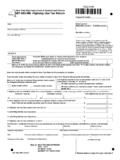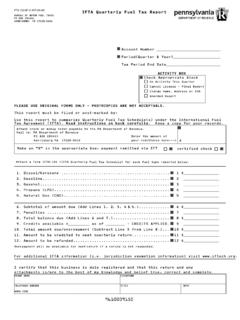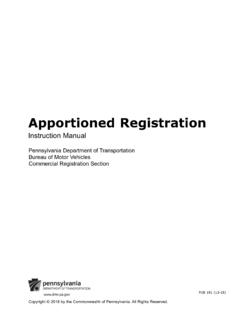Transcription of New York State Department of Taxation and Finance ...
1 For up to the minute tax information including matters that may affect your New york State highway use tax return, visit our Web site at must fileYou must file Form MT 903, highway Use Tax Return, if you have been issued a certificate of registration (certificate) or if you operate a motor vehicle (as defined in Tax Law Article 21) in New york MT 903 is filed monthly, annually, or quarterly, based on the amount of the previous full calendar year s total highway use tax liability: Monthly more than $4,000 Annually $250 or less (with Tax Department approval) Quarterly all others, including carriers not subject to tax in the preceding calendar yearYou may request a change of filing status based on your previous year s liability.
2 Submit your request to: NYS Tax Department , Miscellaneous Tax highway Use, W A Harriman Campus, Albany NY 12227. Be sure to include your taxpayer identification number with your returnsIf you need to file an amended return, use Form MT 903 MN (see Need help? ). When completing the return, be sure to enter the correct figures for the period (not the difference between the figures previously reported and the correct figures). Write Amended on the return and attach an explanation of the changes to the to fileForm MT 903 is due by the last day of the month following the end of the reporting period.
3 The Tax Department will use the postmark date as the filing date for returns and will send you Form MT 903 in time for filing. If you do not receive it, use Form MT 903 MN (see Need help? ).Where to fileMail Form MT 903 to: NYS TAX Department RPC - HUT PO BOX 15166 ALBANY NY 12212-5166 Private delivery servicesIf you choose, you may use a private delivery service, instead of the Postal Service, to mail in your form and tax payment. However, if, at a later date, you need to establish the date you filed or paid your tax, you cannot use the date recorded by a private delivery service unless you used a delivery service that has been designated by the Secretary of the Treasury or the Commissioner of Taxation and Finance .
4 (Currently designated delivery services are listed in Publication 55, Designated Private Delivery Services. See Need help? for information on obtaining forms and publications.) If you have used a designated private delivery service and need to establish the date you filed your form, contact that private delivery service for instructions on how to obtain written proof of the date your form was given to the delivery service for delivery. If you use any private delivery service, whether it is a designated service or not, send the forms covered by these instructions to: NYS Tax Department , RPC HUT, W A Harriman Campus, Albany NY instructionsIf any of the preprinted taxpayer information on Form MT 903 is incorrect, do not make corrections on the return or use a new return.
5 Instead, visit our Web site at and select Online Tax Center. You can also use Form DTF 95, Business Tax Account Update, or Form DTF 96, Report of Address Change for Business Tax Accounts, and attach it to your return. If you need either form, or any other form, see Need help?.If you have had no activity in New york State for this period, mark an X in the appropriate box and enter 0 on line 3. Complete the certification box and follow the mailing instructions in the appropriate boxes on the front of the return the total taxable miles traveled in New york State for this period by all vehicles, and the total miles (including New york State Thruway miles)
6 Traveled in New york State for this period by all highway use tax is due, you must first complete Schedule 1 or Schedule 2, or both, on the back of the form to calculate the amount of tax not report mileage traveled on the toll paid portion of the New york State Thruway, or mileage traveled by buses or other exempt or excluded vehicles. For a definition of exempt vehicles, see Publication 538, A guide to highway Use Tax and other New york State Taxes for 1 is used to calculate the tax due on all miles traveled in New york State (except those miles traveled on the toll paid portion of the Thruway).
7 You must also exclude miles that should be included for tax calculation on Schedule 2 is used to calculate the tax due on the mileage of trucks and tractors that are used almost exclusively in the month to transport: boltwood (short sections of logs, six feet long or less, to be sawed or cut, that are commonly used for specialized items, as in the case of the wood turnery industry), logs (unshaped timber over six feet long, ready for sawing, and commonly used for making lumber), pulpwood (wood for pulp commonly used in making paper), woodchips (small, usually thin, flat pieces of wood cut, struck, or flaked, that are commonly used in making composition board and pulp)
8 And raw, unprocessed milk in miles traveled on the toll paid portion of the Thruway. You may use this schedule only if you have three or fewer trucks or tractors that qualify. If you have more than three trucks or tractors that qualify, all mileage must be included on Schedule exclusively means 90% or more of a motor vehicle s monthly New york State laden miles, whether operated alone or in combination, are used for one of the purposes described. If you use a motor vehicle for more than 10% of the motor vehicle s New york State laden miles during any month for any other purpose, all mileage traveled in New york State (except the toll paid Thruway mileage) must be reported on Schedule 1.
9 The determination must be made on a monthly basis even if you file quarterly or annually. For example, if a truck is used almost exclusively for a Schedule 2 use one month, and is used only 50% of the time for a Schedule 2 use the next month, you would have to include the truck on both schedules if you were filing quarterly. You would, of course, divide the mileage according to the monthly miles are those traveled by a vehicle with a load or any part of a for computing highway use taxWhen you file your first return for the calendar year, you must choose one of the following methods to compute your tax: gross weight method (straight line option or heaviest weight option), or unloaded weight must use this method in computing your tax for each return filed during the year.
10 You may not change the method selected. The method must be used for all of your method you choose should be based on your particular operations. One method may be more economical or convenient for you. For information about record keeping requirements for each of the methods, see Publication weights should be reported in : Referenced Tables 1 through 10 are at the end of these weight methodIf you use the gross weight method, you must use it for every truck and tractor with a gross weight of more than 18,000 pounds operating on New york State public highways during the reporting period.




